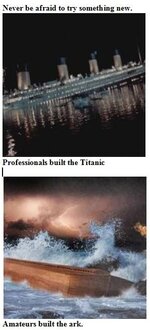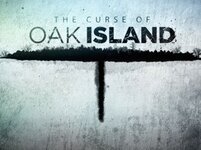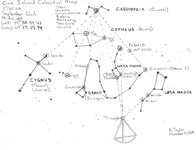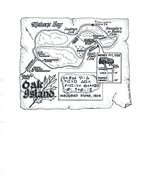This thread is designed for contrarian views to all currently aired theories on Oak Island series TV show,
and for people who can think for themselves and not rely upon what other so-called experts have said
so far. They are theories and nothing more. If the hunters on Oak Island follow every theory from every
self-appointed expert on this subject - they are in for quite a circus ride through the fun house.
This thread is for contrarian views - be they sound possibilities or so completely off the wall they may
actually be closer to the truth than we've heard so far. This thread is NOT for the 'FREEMASON fanatics or their
theories', Templar Knight fanatics, Rosicrucian fanatics, Phoenicians fanatics etc.
By fanatics - we mean people who are convinced they are right, everyone else is wrong, and will listen
to no other idea because they are closed minded on the subject; and in some cases, actually go around the Internet
arguing on every site they can find - with anyone who doesn't buy their theory. We have one here and they have been
placed on my 'ignore' list. This is not a tread for people who think that the treasure has already been removed from
Oak Island. If you wish to prove to the world your 'brilliant' theory about any of the above mentioned topics - start
your own thread and gather your crowd to listen! I'm interested in intelligent people who can think for themselves,
and believe there is actually something of value to still be found on Oak Island.
Also, let's cover some ways to retrieve the treasure that perhaps Rick & Marty Lagina have not considered yet.
I've been recently watching this, seen most episodes now and it just gets stranger and stranger.
Some humorous moments from my viewpoint:
The guy MD'ing on beach finds some colonial coppers and they comment, 'oh the English must have been here.'
My response: "I've found coins older that this in PA! The colonists in the 13 colonies used this as money,
as did the folks up in Novia Scotia!"
The MD'ing signals found and then lost in swamp.
My response: "When dealing with water or water saturated ground, you can and will get false signals!
Where did they go? They were bogus signals!"
They drill into cement like substance, horizontal placed wood, and then vertical placed wood. Someone who drilled
before described drilling cement like substance, horizontal placed woodian for 7" and then 7 feet to next wood
sample.
They assumed it was a treasure vault. They claimed gold flecks on drill bit - I think they made that up to get
investors interest. Sounds somewhat fishy to me but it could have been true.
Gee, this sounds a lot like a mine shaft with a wooden floor and not necessarily a vault of any kind.
The most interesting story regarding that island for me is that it is full of Fool's Gold. Some explorer
mined tons of Fool's gold from Nova Scotia and took it back to Europe - only to find out that it was not real gold.
If he was mining for gold on Oak Island, as some believe - that would explain the underground carverns supposedly on
this island. That would explain why anyone would go to that extreme, digging deep holes in the island - they were
struck by the 'gold bug' and thought they were mining gold. When they discovered it was pyrite - they abandoned their
back-breaking quest.
Perhaps local pirates or privateer discovered these underground caverns and did cache some treasure chests on this
island.
At some point, one or all of these caverns got filled with water. Was it booby-trapped as they seem to think?
It is quite possible the answer is "NO". With all the drilling and digging that has gone on - they could have
unknowingly created a booby-trap for themselves by creating holes that allowed water to enter the caverns from
the ocean, or the swamp, or an underground water supply. Would pirates just simply place chests of gold at the
deepest cavern point on island, and not try to hide that location? Doubtful but would they go to all the trouble
involved of digging a channel of water from the ocean to where the Money Pit is located and at the depth indicated?
I sincerely cannot believe that at all - they were pirates not stone masons.
Another theory I've considered is that the large stone tablet discovered 90 feet below ground was created by
Capt.Kidd or some brilliant privateer -
and properly translated by Professor of Languages James Leitchi who said it says:
"Forty Feet Below, Two Million Pounds Are Buried." Wow, wouldn't that be nice!
I'm an occam's razor thinker on all this - a line of reasoning that says the simplest answer is often correct.
Who had lots of ill-gotten trove in this area? What do you do when there is a too much to spend? You might think
the Capt. of a pirate ship was just a thug but to navigate by the stars, command a successful campaign on the
ships full of treasure along the east coast of N. America heading back to Europe - you had to be an 'educated'
man and probably smarter than the average sword, welding marauder. Some likely genius in their own right.
The occam's razor answer is PIRATES or privateers were most likely behind what is buried at Oak Island.
So it is my theory that the island has been used for multiple purposes by multiple groups. First, someone mined it
for gold and abandoned project. Then others discovered the caverns and decided a perfect place to store trove.
Who is to say it wasn't all recovered? No one has proved that either way. Let's hope it still exists!
The TH'ing dreamer in me hopes that the two brothers spending all this money find something of value to offset
what they have invested. But it's looking more and more like it is possible that all the theories about the Templar
Knights, The Holy Grail, The Ark of the Covenant, Solomon's Tree of Life, the Phoenicians etc. - are amazing stories
but have no foundation in them whatsoever. My best guess - pirates/privateer treasure was cached after someone else
worked
the island for fool's gold. I do hope they find the motherload and before Dan passes on. I wish H2 network would stop
promoting 'seven people must die' before they get down 235 feet to the present chamber area the team is working.
235 feet! It's a long way to finding anything in a water filled hole possibly fed by the ocean. Time will tell.
Retrieval method 'outside the box': get down to where treasure is located, use robotics to drill into side of any
chests and see what is inside there? Then split open any chests with underwater robotics or underwater explosives,
then use traditional ocean floor vacuums commonly used by treasure salvagers - to remove all coins, use robotics to
carry up larger objects such as gold bars or silver bars. No life is put at risk, no one dies or gets hurt.
So do you have a serious contrarian view or idea to most of what is being peddled as the best and only possible
answer to this puzzle on The Series and here on T-net? We'd like to hear it.
A good site with a historical timeline of TH'ers so far:
Oak Island Money Pit - The Last Great Unsolved Mystery
The historical record of searches on Oak Island says:
1849 (gold found)
"Beneath the layer of settled dirt, the Truro Company noticed that the auger then penetrated a series of strata
consisting of 4 inches of oak, followed by 6 inches of spruce, before entering seven feet of clay. To the crew, the
oak and spruce represented more than just a new configuration of wood platforms. After so many failed attempts, this
could finally be a chest containing the riches they sought. When the operators withdrew their probe from the pit,
they were given even more reason for excitement. Attached to the auger, the men of the Truro Company found three
small links of gold chain (Lamb, 2006)."
1897 (traces of gold found)
"Another discovery made during that excavation only came to light many years following the summer of 1897. As
indicated by Lamb, during that fateful excavation, drill operator William Chappell found traces of gold sediment on
the auger after drilling into the Money Pit (2006). Similar to James Pitblado, formerly of the Truro Company,
Chappell hid his valuable discovery from fellow crewmembers. It was not until 1931 that Chappell's findings would
come to light."

addendum:
Rick and Marty team - if you're reading this post: There's a guy on this site who is a Freemason theorist (Royal
Society of London, Baconist (primary), and Alchemists). He'd really like an audience with your team. Hence, he finds
'anyway necessary' to post on every thread on this site that is about Oak Island. Perhaps your team could invite him
to your 'war room' so he can explain to you how there is no treasure now and why. That'd be great for us because then
maybe we could have a string of posts that do include what this tread was designed to be about. I tried to be nice
about it and clearly spell that out on the first post - that didn't work the first time or the second time (no real
surprise there); and he has his own thread on oak island on this site dated Dec 02, 2014 02:47 PM. Thoughtful
consideration of this request and it's implied 'real meaning' will surely help you understand the deal here with
this somewhat odd scenario.

and for people who can think for themselves and not rely upon what other so-called experts have said
so far. They are theories and nothing more. If the hunters on Oak Island follow every theory from every
self-appointed expert on this subject - they are in for quite a circus ride through the fun house.
This thread is for contrarian views - be they sound possibilities or so completely off the wall they may
actually be closer to the truth than we've heard so far. This thread is NOT for the 'FREEMASON fanatics or their
theories', Templar Knight fanatics, Rosicrucian fanatics, Phoenicians fanatics etc.
By fanatics - we mean people who are convinced they are right, everyone else is wrong, and will listen
to no other idea because they are closed minded on the subject; and in some cases, actually go around the Internet
arguing on every site they can find - with anyone who doesn't buy their theory. We have one here and they have been
placed on my 'ignore' list. This is not a tread for people who think that the treasure has already been removed from
Oak Island. If you wish to prove to the world your 'brilliant' theory about any of the above mentioned topics - start
your own thread and gather your crowd to listen! I'm interested in intelligent people who can think for themselves,
and believe there is actually something of value to still be found on Oak Island.
Also, let's cover some ways to retrieve the treasure that perhaps Rick & Marty Lagina have not considered yet.
I've been recently watching this, seen most episodes now and it just gets stranger and stranger.
Some humorous moments from my viewpoint:
The guy MD'ing on beach finds some colonial coppers and they comment, 'oh the English must have been here.'
My response: "I've found coins older that this in PA! The colonists in the 13 colonies used this as money,
as did the folks up in Novia Scotia!"
The MD'ing signals found and then lost in swamp.
My response: "When dealing with water or water saturated ground, you can and will get false signals!
Where did they go? They were bogus signals!"
They drill into cement like substance, horizontal placed wood, and then vertical placed wood. Someone who drilled
before described drilling cement like substance, horizontal placed woodian for 7" and then 7 feet to next wood
sample.
They assumed it was a treasure vault. They claimed gold flecks on drill bit - I think they made that up to get
investors interest. Sounds somewhat fishy to me but it could have been true.
Gee, this sounds a lot like a mine shaft with a wooden floor and not necessarily a vault of any kind.
The most interesting story regarding that island for me is that it is full of Fool's Gold. Some explorer
mined tons of Fool's gold from Nova Scotia and took it back to Europe - only to find out that it was not real gold.
If he was mining for gold on Oak Island, as some believe - that would explain the underground carverns supposedly on
this island. That would explain why anyone would go to that extreme, digging deep holes in the island - they were
struck by the 'gold bug' and thought they were mining gold. When they discovered it was pyrite - they abandoned their
back-breaking quest.
Perhaps local pirates or privateer discovered these underground caverns and did cache some treasure chests on this
island.
At some point, one or all of these caverns got filled with water. Was it booby-trapped as they seem to think?
It is quite possible the answer is "NO". With all the drilling and digging that has gone on - they could have
unknowingly created a booby-trap for themselves by creating holes that allowed water to enter the caverns from
the ocean, or the swamp, or an underground water supply. Would pirates just simply place chests of gold at the
deepest cavern point on island, and not try to hide that location? Doubtful but would they go to all the trouble
involved of digging a channel of water from the ocean to where the Money Pit is located and at the depth indicated?
I sincerely cannot believe that at all - they were pirates not stone masons.
Another theory I've considered is that the large stone tablet discovered 90 feet below ground was created by
Capt.Kidd or some brilliant privateer -
and properly translated by Professor of Languages James Leitchi who said it says:
"Forty Feet Below, Two Million Pounds Are Buried." Wow, wouldn't that be nice!
I'm an occam's razor thinker on all this - a line of reasoning that says the simplest answer is often correct.
Who had lots of ill-gotten trove in this area? What do you do when there is a too much to spend? You might think
the Capt. of a pirate ship was just a thug but to navigate by the stars, command a successful campaign on the
ships full of treasure along the east coast of N. America heading back to Europe - you had to be an 'educated'
man and probably smarter than the average sword, welding marauder. Some likely genius in their own right.
The occam's razor answer is PIRATES or privateers were most likely behind what is buried at Oak Island.
So it is my theory that the island has been used for multiple purposes by multiple groups. First, someone mined it
for gold and abandoned project. Then others discovered the caverns and decided a perfect place to store trove.
Who is to say it wasn't all recovered? No one has proved that either way. Let's hope it still exists!
The TH'ing dreamer in me hopes that the two brothers spending all this money find something of value to offset
what they have invested. But it's looking more and more like it is possible that all the theories about the Templar
Knights, The Holy Grail, The Ark of the Covenant, Solomon's Tree of Life, the Phoenicians etc. - are amazing stories
but have no foundation in them whatsoever. My best guess - pirates/privateer treasure was cached after someone else
worked
the island for fool's gold. I do hope they find the motherload and before Dan passes on. I wish H2 network would stop
promoting 'seven people must die' before they get down 235 feet to the present chamber area the team is working.
235 feet! It's a long way to finding anything in a water filled hole possibly fed by the ocean. Time will tell.
Retrieval method 'outside the box': get down to where treasure is located, use robotics to drill into side of any
chests and see what is inside there? Then split open any chests with underwater robotics or underwater explosives,
then use traditional ocean floor vacuums commonly used by treasure salvagers - to remove all coins, use robotics to
carry up larger objects such as gold bars or silver bars. No life is put at risk, no one dies or gets hurt.
So do you have a serious contrarian view or idea to most of what is being peddled as the best and only possible
answer to this puzzle on The Series and here on T-net? We'd like to hear it.
A good site with a historical timeline of TH'ers so far:
Oak Island Money Pit - The Last Great Unsolved Mystery
The historical record of searches on Oak Island says:
1849 (gold found)
"Beneath the layer of settled dirt, the Truro Company noticed that the auger then penetrated a series of strata
consisting of 4 inches of oak, followed by 6 inches of spruce, before entering seven feet of clay. To the crew, the
oak and spruce represented more than just a new configuration of wood platforms. After so many failed attempts, this
could finally be a chest containing the riches they sought. When the operators withdrew their probe from the pit,
they were given even more reason for excitement. Attached to the auger, the men of the Truro Company found three
small links of gold chain (Lamb, 2006)."
1897 (traces of gold found)
"Another discovery made during that excavation only came to light many years following the summer of 1897. As
indicated by Lamb, during that fateful excavation, drill operator William Chappell found traces of gold sediment on
the auger after drilling into the Money Pit (2006). Similar to James Pitblado, formerly of the Truro Company,
Chappell hid his valuable discovery from fellow crewmembers. It was not until 1931 that Chappell's findings would
come to light."

addendum:
Rick and Marty team - if you're reading this post: There's a guy on this site who is a Freemason theorist (Royal
Society of London, Baconist (primary), and Alchemists). He'd really like an audience with your team. Hence, he finds
'anyway necessary' to post on every thread on this site that is about Oak Island. Perhaps your team could invite him
to your 'war room' so he can explain to you how there is no treasure now and why. That'd be great for us because then
maybe we could have a string of posts that do include what this tread was designed to be about. I tried to be nice
about it and clearly spell that out on the first post - that didn't work the first time or the second time (no real
surprise there); and he has his own thread on oak island on this site dated Dec 02, 2014 02:47 PM. Thoughtful
consideration of this request and it's implied 'real meaning' will surely help you understand the deal here with
this somewhat odd scenario.


Last edited:








 and dug a bunch of tunnels in the process?
and dug a bunch of tunnels in the process?


